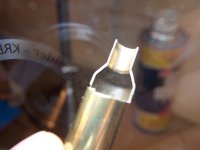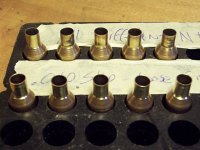When turning necks on stock Lapua 220 Russian brass for a 6 ppc, (.262 neck) how far down the neck do I cut in order to get the neck - shoulder junction at the proper point so that I do not create a donut? Pictures are worth a 1000 words. I don't want to cut too deep causing the possibility of neck separation but cut too short results in the dreaded donut. Where do you stop?
Thanks, Bro.D
Thanks, Bro.D





